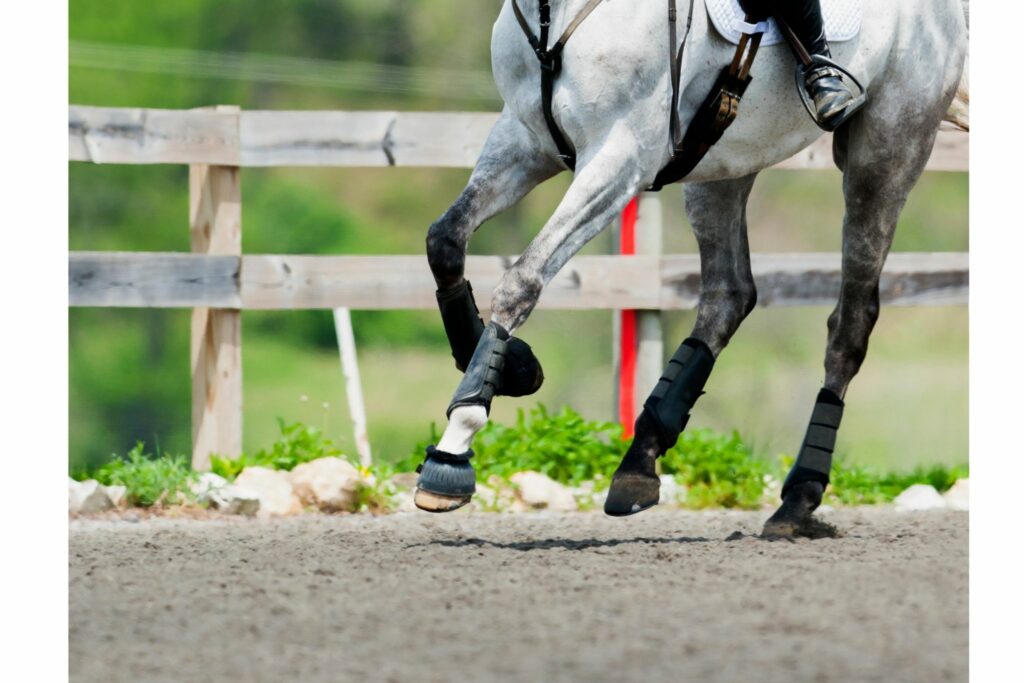Boots only protect horses when applied correctly
Also known as overreach boots, bell boots are an essential piece of protective gear for certain horses. Overreaching, or when a horse steps on the back of a front limb with a hind hoof, can be a serious problem for horses and their owners.
Bell boots are a great way to prevent overreach injuries (along with pulling shoes and extra farrier visits!). These boots also provide extra protection for your horse when riding or during turnout. In this article, we look at common bell boots styles and materials and how to put them on.
What are bell boots in a nut shell?
Bell boots are a piece of protective equipment that wraps around the horses’ feet.
They cover the pastern over the coronary band and the hoof wall down to the heel.
They provide great protection from overreaching and interference from the hind hooves hitting the back of the fronts.
Why might you use bell boots?
Many horse owners will put bell boots on a horse before turning it out in the field to help prevent the horse from pulling a shoe.
They can also be used when your horse may overreach like during lunging or hauling in a trailer if the shipping wraps don’t cover the pasterns or heels.
How much do bell boots cost?
The price of bell boots ranges from $15 to over $120. There are many different styles and variations that make up for the price difference.
For example, some are made with fleece around the top. This style, while more expensive, is great if your horse has sensitive skin and is susceptible to rubbing.
Common Bell Boot Materials:
- Rubber is the most common material used for bell boots as it is flexible, lightweight, very durable, and is waterproof. They are slightly heavier than the traditional boots made from gum. You can find both open and closed styles along with fleece-lining for added comfort.
- Neoprene is a soft, flexible, and resilient material. This is a great option to provide comfort for your horse. Boots with a faux leather exterior and neoprene lining tend to be a bit more expensive but a very durable option.
- Many no-turn bell boots are made of nylon. This is an extremely durable and lightweight material. A nylon lining offers softness and protection for your horses’ legs.
- Traditional gum rubber bell boots are the most common and simple boots you’ll find. They are generally only available in a pull-on style and are very lightweight and stretchy.
- Carbon-Fiber boots are a great option for horses that are really hard on their boots. These are especially good for vigorous jumping as they are lightweight, but very strong, and offer a high level of impact protection.

Photo Cred: Canva
How to Put On Bell Boots
The way to put on bell boots depends on the style of the boot. Boots with Velcro tend to be easier to put on, but may also come off easier as the Velcro weakens.
For horses that like to chew their accessories, Velcro bell boots may make for a fun challenge (and lost boots).
Velcro:
Velcro bell boots are a bit easier to put on your horse. You do run the risk of the Velcro coming undone and losing the boot, compared to pull-on boots. You’ll simply place the boot around your horses’ ankle and fasten them, making sure they’re secure.
Here is a video demonstrating how to safely put Velcro bell boots on your horse:
Pull-on:
Pull-on bell boots can be a bit trickier to put on, especially with an impatient horse. To apply, you do have to pick the hoof up and pull the bell boot on.
A tip with these is to turn them inside out and hold the bottom rim while putting the boot over the toe of the hoof.
Here is a video showing how to pull on the bell boots:
Frequently Asked Questions
Q: Can you leave bell boots on all the time?
You can leave bell boots on for extended periods of time, but it is best to remove them periodically to allow your horses’ legs to get air. Leaving boots on all the time can lead to irritation, bacterial infections, and chafing or hair loss.
Q: How do you put on horse exercise boots?
Most exercise boots utilize Velcro for easy on and off. Simply place the boot around your horses’ leg and Velcro (or attach) properly. Ensure the boot fits correctly by sliding your finger in between the leg and boot. If you can’t fit your finger under it, you may want to loosen the straps. If there is a lot of wiggle room you’ll want to tighten the straps.
Q: Do bell boots go on back legs?
Bell boots are primarily designed to protect against overreaching, or injuring the front lower leg with the hind hooves. For this reason, it is uncommon to use bell boots on the hind legs.
Q: How do you put rubber bell boots on a horse?
To apply rubber pull-on bell boots, you can turn them inside out and hold the bottom rim while putting the boot over the toe of the hoof and pulling up. Once the boot is around the ankle, you’ll then flip it right side out.
Parting Thoughts
Bell boots are a great accessory to have for a variety of situations. If your horse is pulling their shoes regularly in turnout you may want to look into a pair of boots. With a wide range of prices and materials you’ll be sure to find something that works great for your four-legged friend. Happy riding!
P.S. Enjoy this article? Trot on over to:
- 4
Dressage Fashion Trends & Salute-Worthy Styles - Shipping Boots vs. Stocking Wraps – What Do I Use?
- 5 Comfy Tall Riding Boots That Look as Good as They Feel
- 3 Best
Dressage Boots for the Perfect Leg Position - 10 Best Brands of No-Regrets Breeches
- Fashion Dos and Don’ts for Horse Show Spectators









